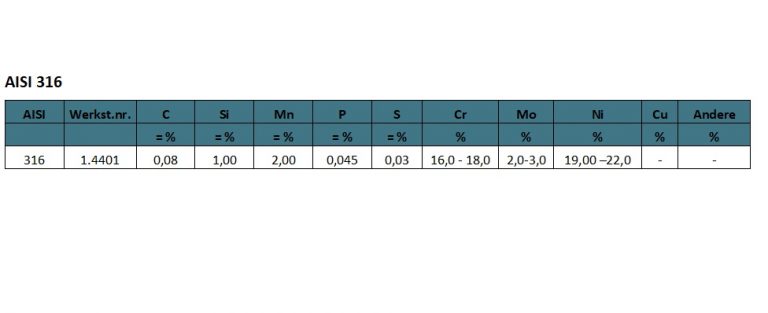In our delivery program, we have several stainless steel alloys.
These alloys can be divided in different methods.
One of the most known methods is the AISI (American Iron and Steel Institute).
This method of categorization uses a three-digit code. If there is a special chemical property with a certain alloy, this code is supplemented with a letter.
In the AISI method contains the following series:
* 200-series Chrome nickel manganese steel which has got an austenitic structure.
* 300-series Chrome nickel steel which has got an austenitic structure.
* 400-series Chrome steel with a ferritic or martensitic structure.
Next to the AISI method to categorize alloys, there is also a German method. In this categorization method, the stainless steel alloys are indicated by a so-called ‘Werkstoffnumer’.
The AISI method doesn’t match exactly to the Werkstoffnummer-type designation. The differences are minimal but could be a cause for changes during processes such as welding.
Furthermore, these differences can be a consequence of product contamination, stress corrosion, etc.
This table shows which AISI-number correspond to which Werkstoff number.
The majority of the stainless steel comes mainly from the 300-series.
Alloys from this series consist out of a structure of 18% Chrome and 8% Nickel, also known as the 18/8 composition.
Because of increasing or decreasing, add or omitting materials, the characteristic properties change.
The delivery program of Mesh Masters consists mainly out of the 300-series.
That is why in the undermentioned overview you can find several of these alloys highlighted.
AISI 304
By far the most used alloy is AISI 304. This alloy isn’t magnetic in annealed condition. This could change when the alloy is cold treated.
AISI 304 is an alloy that is often used in the food industry, pharmaceutical industry, chemical process industry and refineries.

AISI 304L
In comparison of the AISI 304, the AISI 304L has got a lower amount of carbon. Because of this, this alloy is better resistant against intercrystalline corrosion which can occur after welding or annealing.
This alloy is used when parts after welding can’t be annealed and with material that is in contact with various corrosive agents.
AISI 304L is resistant up to a temperature of 425°C

AISI 310
AISI 310 has got less carbon than AISI 304(L) and because of that, it has got it’s characteristic that it can handles temperature up to 1040°C.
Furthermore, the weldability of this alloy is very good.
In the chemical- and petrochemical industry, this alloy is applied often.

AISI 316
In addition to AISI 304, this alloy is most common in our delivery program.
AISI 316 is a chrome-nickel-molybdenum alloy. It has got corrosion properties which are much better as other chrome-nickel-steel alloys. Because of this, it is applied often in corrosive environments and marine climates.
AISI 316 is can be found in chemical industries, petrochemical industries, pharmaceutical industries, shipping, etc.

AISI 316L
This alloy can be compared with AISI 316. However, 316L has got less carbon and because of this a better resistance to intracrystalline corrosion after welding or low voltage annealing.
This alloy can be applied where it comes into contact with corrosive materials or that must be machined by welding but can’t be annealed afterwards.
AISI 316L is suitable to be exposed to temperatures up to 425°C.

AISI 321
AISI 321 is an alloy that contains titan to stabilize the carbon.
This alloy can’t be annealed after welding. AISI 321 is applied at places where it comes in contact with corrosive materials. AISI 321 is suitable for applications where temperatures can get between 425°C and 900°C in certain corrosive environments.
AISI 321 can be used in, for example, aviation, aerospace, heating elements and furnace parts.
AISI 321 is geschikt voor toepassingen waar het aan temperaturen wordt blootgesteld tussen de 425°C en 900°C in bepaalde corrosieve omgevingen. AISI 321 is te gebruiken in bijvoorbeeld de luchtvaart, ruimtevaart, verwarmingselementen en ovenonderdelen.

AISI 347
With AISI 347, niobium and tantalium are added to stabilize the carbon.
This alloy can be used where it is exposed to a corrosive environment. Furthermore, this is suitable for parts that are produced by welding and can’t be annealed afterwards.
AISI 347 can be applied within temperatures between 425°C and 900°C and afterwards, can be exposed to a corrosive environment.

